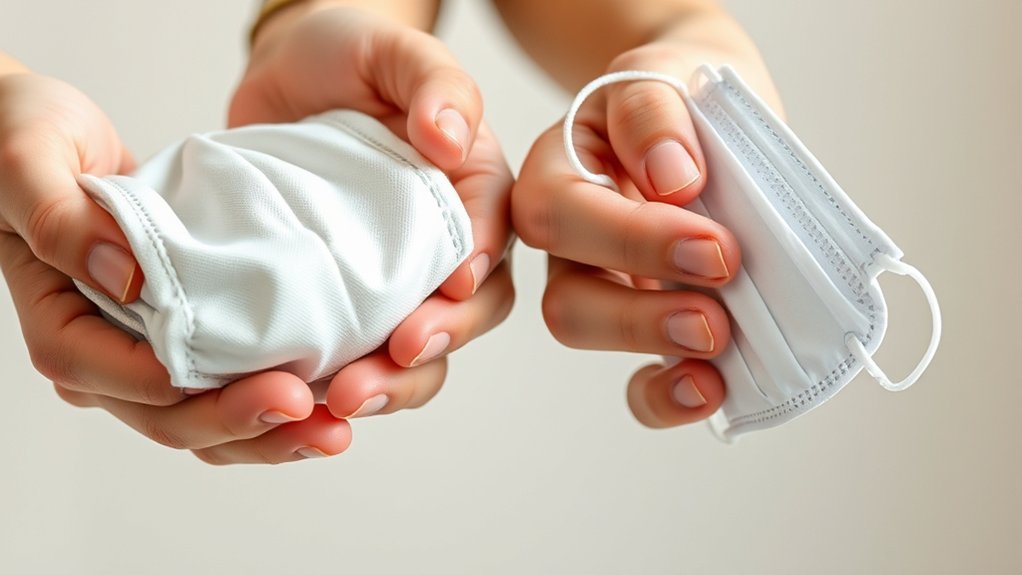Imagine a parent choosing between cloth diapers and disposables for their newborn. Both options come with distinct benefits, but understanding how to maximize their effectiveness is essential. Regular maintenance and material selection can greatly impact health and environmental outcomes. So, what factors should you consider to make an informed decision that aligns with your lifestyle and values? Let’s explore the nuances of cloth versus disposable products and the prevention tips that can enhance their use.
The Benefits of Cloth Products
When considering the choice between cloth and disposable products, many people find that cloth options offer distinct advantages. One significant benefit is cost savings. Though the initial investment in cloth products may be higher, their reusability translates into long-term financial benefits, as you won’t need to continuously purchase disposables.
Additionally, the comfort factor can’t be overlooked. Cloth materials tend to be softer against your skin, reducing irritation and enhancing your overall experience. You can choose from various fabrics that suit your personal preferences, promoting comfort during everyday use.
Moreover, cloth products contribute to environmental sustainability, aligning with a desire for liberation from wasteful practices. Ultimately, these advantages make cloth products a compelling choice for those seeking both comfort and economic efficiency.
The Advantages of Disposable Products
While cloth products have their merits, disposable options present several practical advantages that can’t be ignored.
The convenience factor of disposables is significant; you can simply use and toss them, saving time on washing and drying. This ease of use allows you to focus more on your daily activities without the added chore of maintenance.
Additionally, when considering cost effectiveness, disposables often come at a lower initial investment, especially for those who may not use them frequently. They eliminate the need for special detergents and equipment, making them budget-friendly in the long run.
Disposable options often require a lower initial investment and eliminate the need for special detergents, making them budget-friendly over time.
Ultimately, disposable products can provide a liberating experience, allowing you to prioritize ease and efficiency in your life without the burdens of upkeep.
Environmental Impact: Cloth Vs Disposable
Although disposable products may offer convenience, their environmental impact raises significant concerns that are hard to overlook. Each year, millions of tons of disposable items end up in landfills, contributing to severe waste management issues.
The production and disposal of these products also lead to increased greenhouse gas emissions, exacerbating climate change. In contrast, cloth alternatives promote sustainability by reducing waste and encouraging a circular economy.
By choosing cloth, you not only minimize your carbon footprint but also support practices that prioritize resource conservation. It’s essential to weigh the immediate convenience of disposables against the long-term benefits of cloth options.
Ultimately, embracing sustainable choices will foster a healthier planet and empower future generations to live in harmony with nature.
Health Considerations for Both Options
The choice between cloth and disposable products isn’t just about environmental impact; health considerations play a significant role as well. Cloth products can harbor bacteria if not washed properly, leading to potential health risks. Conversely, disposable options may contain chemicals that trigger allergy concerns.
| Option | Health Risks |
|---|---|
| Cloth | Bacterial growth, skin irritation |
| Disposable | Chemical exposure, allergic reactions |
When you weigh your options, consider how each choice could affect your well-being. Cloth may require diligent care, while disposables might provide convenience with hidden risks. Ultimately, your decision should align with your health priorities and lifestyle choices, ensuring you’re empowered in your selection.
Making the Right Choice for Your Lifestyle
Choosing between cloth and disposable products involves careful consideration of how each aligns with your lifestyle and values.
If sustainability practices are a priority for you, cloth products often provide a more eco-friendly option, reducing landfill waste and resource consumption.
However, if convenience fits your lifestyle preferences better, disposables can save time and effort.
It’s essential to evaluate your daily routines, budget, and environmental impact when making this choice.
Consider the long-term benefits of cloth versus the immediate ease of disposables.
Ultimately, the right choice reflects your commitment to sustainable living while accommodating your personal needs.
Frequently Asked Questions
How Do I Properly Clean Cloth Products?
To properly clean cloth products, use effective cleaning techniques like washing in hot water, applying stain removers, and air drying. Regular maintenance tips include inspecting for wear and promptly addressing any damage to prolong their lifespan.
Are Disposable Products Safe for Sensitive Skin?
Yes, disposable products can be safe for sensitive skin, but it depends on the materials used. Look for hypoallergenic options to minimize irritation and avoid harmful chemicals often found in conventional disposable materials.
Can Cloth Products Cause Allergic Reactions?
Cloth products can trigger allergy symptoms in some individuals, particularly if they contain specific fabric materials like wool or synthetic fibers. Pay attention to your body’s reactions and choose materials that promote comfort and freedom from irritation.
What Is the Cost Difference Over Time?
The initial investment in cloth products is higher, but over time, you’ll enjoy significant long-term savings. Analyzing costs reveals that reusable options often outperform disposables, ultimately leading to financial freedom and environmental benefits.
How Do I Store Reusable Cloth Products?
“Out of sight, out of mind.” To store reusable cloth products, choose breathable containers, avoid damp areas, and consider fabric types. Follow these storage tips to keep them fresh and ready for use whenever you need.
Conclusion
In choosing between cloth and disposable products, it’s key to weigh your options carefully. Cloth can offer long-term savings and reduced waste, but requires diligent upkeep, much like maintaining a classic car. On the other hand, disposables provide convenience but come with environmental concerns. By understanding the benefits and drawbacks of each, you can make an informed choice that aligns with your lifestyle, health needs, and values, ensuring you’re driving towards a sustainable future.
